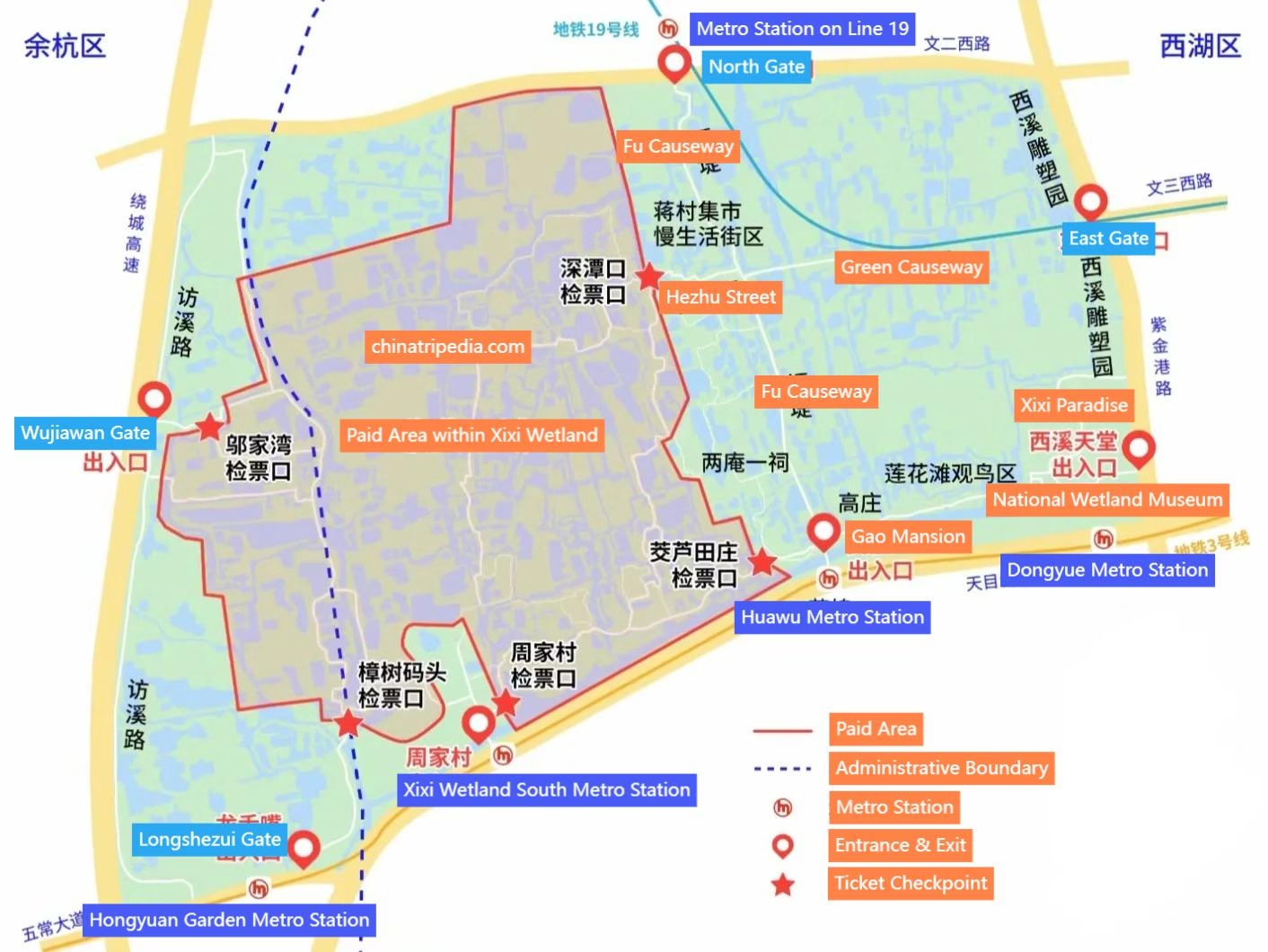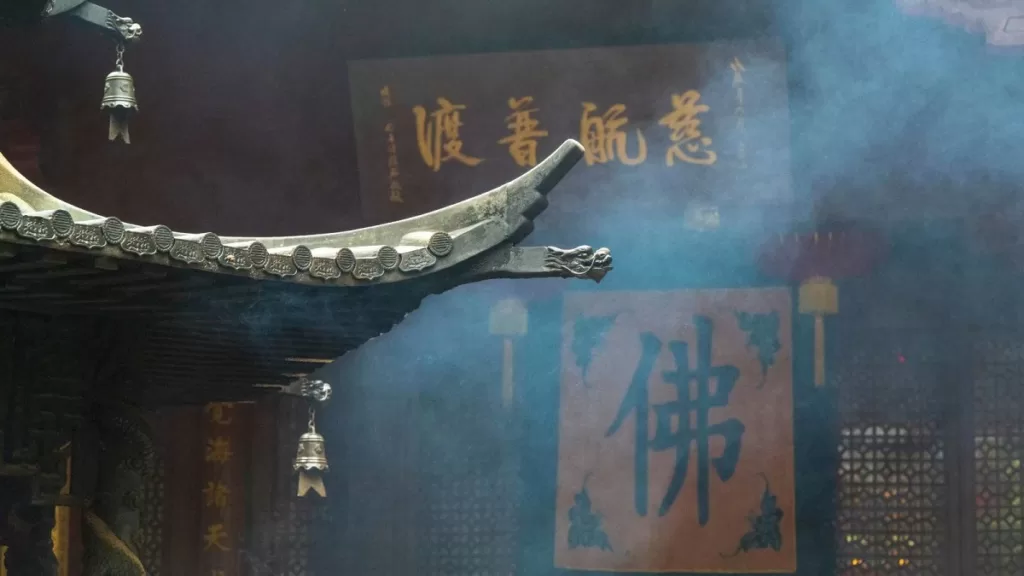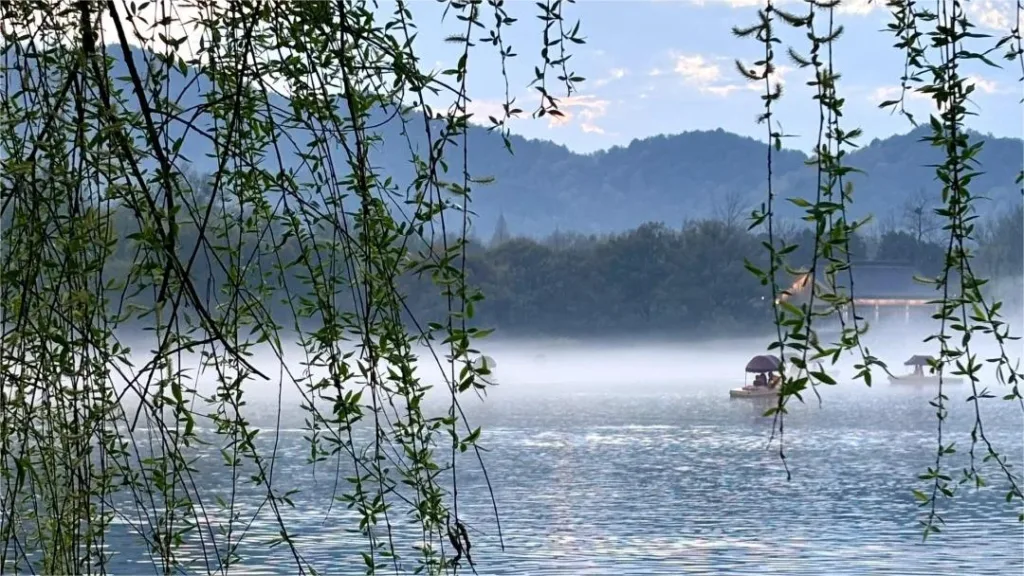Xixi National Wetland Park (西溪国家湿地公园) in Hangzhou, Zhejiang Province spans an impressive 11.5 square kilometers, with over 100 kilometers of winding rivers and approximately 70% of its area consisting of water bodies like river ports, ponds, lakes, and marshes. Its history dates back to the Han and Jin dynasties, flourished during the Tang and Song dynasties, reached its peak during the Ming and Qing dynasties, experienced decline in the Republican era, and has been revitalized in contemporary times. It stands as China’s first national wetland park integrating urban, agricultural, and cultural wetlands, earning the moniker “Three Xis” alongside West Lake (xihu) and Xiling.
Xixi boasts a 300-acre plum forest featuring various species such as Jiangmei, Gongfen, Zhusha, Lü’e, Yudie, and Meirenmei. From December through March, visitors can witness a succession of blooming plum blossoms, showcasing a diverse array of colors and fragrances.
The park is divided into two sections: the newly developed Hongyuan Garden in the west and the essence of natural beauty in the east. Navigating through the intricate waterways by boat there provides the optimal way to immerse oneself in the park’s natural ecology, offering an unparalleled experience of nature’s wonders.
Table of Contents
- Basic Information
- Location and Transportation
- Map of Xixi National Wetland Park
- Highlights of Xixi National Wetland Park
- Vlog about Xixi National Wetland Park
- Other Iconic Attractions in Hangzhou
Basic Information
| Estimated Length of Tour | Half a day |
| Ticket Price | 80 RMB |
| Electric Boat | 60 RMB |
| Battery Car | Single Way: 10 RMB Round: 20 RMB |
| Opening Hours | 7.30 – 18.30 (1st April – 7th October) 8.00 – 17.30 (8th October – 31st March) |
| Telephone Number | 0086-0571-88106688 0086-0571-88106696 |
Location and Transportation
Xixi National Wetland Park is strategically located at the intersection of Xihu District and Yuhang District in Hangzhou, Zhejiang Province, China, near the National Wetland Museum of China. Situated less than 5 kilometers away from the renowned West Lake and a mere 6 kilometers from the Wulinmen area in the central part of Hangzhou, the park enjoys a prime location that makes it easily accessible from the heart of the city. To get there, you can choose one of the following ways:
Bus: Take bus 83 or 86 and get off at Xixi Wetland North Gate Stop (西溪湿地公园北门站). Or take bus 277, 382, or 7006M and get off at Huawu Stop (花坞站) to reach the south gate of the park.
Metro: There are three metro stations around Xixi National Wetland Park. They are the Xixi Wetland North (西溪湿地北) on line 19, which leads to the north gate of the park, Huawu (花坞) on line 3 near the ticket office, and Xixi Wetland South (西溪湿地南) on line 3, which leads to the west part of the park.
Map of Xixi National Wetland Park

Highlights of Xixi National Wetland Park
Bo An (Bo Mansion)

Originally the estate of Qiantang native Zou Xiaozhi, also known as Master Ji, Bo An dates back to the late Ming and early Qing dynasties. The area was once covered with flourishing reeds, creating a picturesque scene. The estate appears as if an immortal island is anchored on the water when viewed from a distance, giving it its name. Bo An features two sets of buildings, Zizai Tang and Kongming Xuan, which echo each other, creating three distinct spaces from south to north.
Yanshui Yuzhuang (Mist and Water Fishing Resort)

Yanshui Yuzhuang serves as the cultural showcase center for Xixi’s agricultural and fishing heritage. Drawing inspiration from the poetic imagery of Chen Wenshu’s “Autumn Snow at the Fishing Village” during the Qing dynasty, it is named after the enchanting mists of willow smoke, cooking smoke, and water vapor. The site includes exhibitions on silkworm silk stories, marriage customs, and local households, offering insights into the distinctive features of water village dwellings and the simple agricultural culture of its residents.
Li Hang Er Gong Ci (Temple Dedicated to Two Scholars)

Li Hang Er Gong Ci is one of the ancestral halls in Xixi specifically dedicated to venerating literati. It stands alongside Qiuxue Temple, another shrine for poets from Zhejiang. The two honored figures in this shrine are Li E, also known as Taihong, and Hang Shijun, also known as Taizong, who were notable scholars and poets in Hangzhou during the Qing dynasty. This site has been meticulously restored to serve as a gathering place for literary scholars, providing a space for poetry discussions, calligraphy, and artistic expressions, fostering a rich cultural atmosphere.
Hezhu Street

Hezhu Street is a folk commercial street seamlessly combining leisure, trade markets, and sightseeing. The street preserves the historical layout of people’s daily lives and activities. Waterfront loft buildings, scattered small boats passing under bridges, and the folk legends passed down through generations create an ambiance that vividly portrays the water town lifestyle – where islands are homes, and boats serve as steeds.
Gaozhuang (Gao Mansion)

Also known as Xixi Mountain Villa or Xizhuang, Gaozhuang dates back to the period between the 14th year of the Shunzhi era (1657) and the third year of the Kangxi era (1664) during the Qing dynasty. It was the mountain villa of the literatus Gao Shiqi (1645–1704), featuring the typical characteristics of official residences with front courtyards and rear gardens from the late Ming to mid-Qing periods. Gaozhuang gained fame when Emperor Kangxi visited the area during his southern tour. The villa, comprised of high mansions, bamboo windows, and a banana garden poetry society, recreates the historical scene of Kangxi’s visit, offering a glimpse into the past grandeur.
Wetland Botanical Garden

Also known as Xixi Mountain Villa or Xizhuang, Gaozhuang dates back to the period between the 14th year of the Shunzhi era (1657) and the third year of the Kangxi era (1664) during the Qing dynasty. It was the mountain villa of the literatus Gao Shiqi (1645–1704), featuring the typical characteristics of official residences with front courtyards and rear gardens from the late Ming to mid-Qing periods. Gaozhuang gained fame when Emperor Kangxi visited the area during his southern tour. The villa, comprised of high mansions, bamboo windows, and a banana garden poetry society, recreates the historical scene of Kangxi’s visit, offering a glimpse into the past grandeur.
River Embankments

Xixi National Wetland Park features three river embankments, each with its unique characteristics.
- Fu Embankment (福堤): This embankment spans approximately 2300 meters and is adorned with six bridges, each bearing the character “福” (fortune). It seamlessly connects the park’s southern and northern exits, serving as a linkage between the main attractions within the park.
- Green Embankment (绿堤): Stretching 1600 meters from east to west and 7 meters in width, the Green Embankment is flanked by lush vegetation, creating a picturesque and ecologically vibrant environment.
- Longevity Embankment (寿堤): Running parallel to the Wuchang Harbor, the Shou Embankment extends approximately 5470 meters from north to south. With a width of 4.5 meters, it stands as the longest embankment in Xixi Wetland Park, symbolizing longevity. The banks of Shou Embankment are crisscrossed by water networks, adorned with ancient trees, exuding a serene and natural beauty.









Since I spent 80 yuan on the entrance ticket and 60 yuan on the boat ticket, I felt it was actually quite average. You could say the scenery is nice, but it’s just typical park views. It’s better to stroll around the free areas; I wouldn’t recommend going to the paid section.